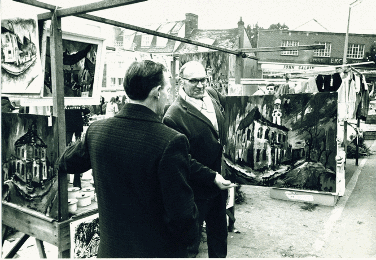An Artist 30 Years Ahead of his Time
British Artist Cyril Hamersma

Born 1919 and died in 1994, this prolific artist lived in London until 1960, though punctuated by service in World War II (1939 - 45) when he was posted to Greece in the Royal Medical Army Corps. Here he was captured and held a Prisoner of War (in Stalag VIIIB, Germany) for 4 years.
The paintings displayed on this site no longer exist. They were large and so numerous that storage was impossible and they deteriorated badly within a year or two of their being photographed. We are grateful to the staff and volunteers at Braintree District Museum in Essex, UK, for preserving the images in digital format
Hamersma sold several paintings in this style - bright geometric colours on a black background - in the 1950s  whilst living in London and exhibiting successfully in some London Galleries.
whilst living in London and exhibiting successfully in some London Galleries.
He explored abstract art with pure colours and fine brushes but would never completely abandon his leanings toward abstract expressionism using broad strokes, collage and mixed media, as in the 'Green Woman' below.

Always 30 years ahead of his time Hamersma’s artwork regularly focused on the simple things in life: a juicy red apple; a welcoming pot of tea; a freshly fried egg – the basics of which he was, along with many thousands of men, deprived for four years as a prisoner of war in Germany in World War II.
He was fascinated by ‘the line’ in art. Where does one object finish and another begin, when you look at them as a two dimensional image?
And every object is made up of cells, minuscule cells invisible to the naked eye but Hamersma exploded ideas and looked further into them, painting and drawing ‘cells’; images made up of cells; ‘metaphysical cell structures’ which led him to invent the Squircle.

It was his Squircle work that became the pinnacle. “The Squircle is Art, Science and Religion – together in one image,” he said in January 1994. “Light invites everyone to join the fight against the darkness. ….” he wrote in March 1994, just six months before his death.